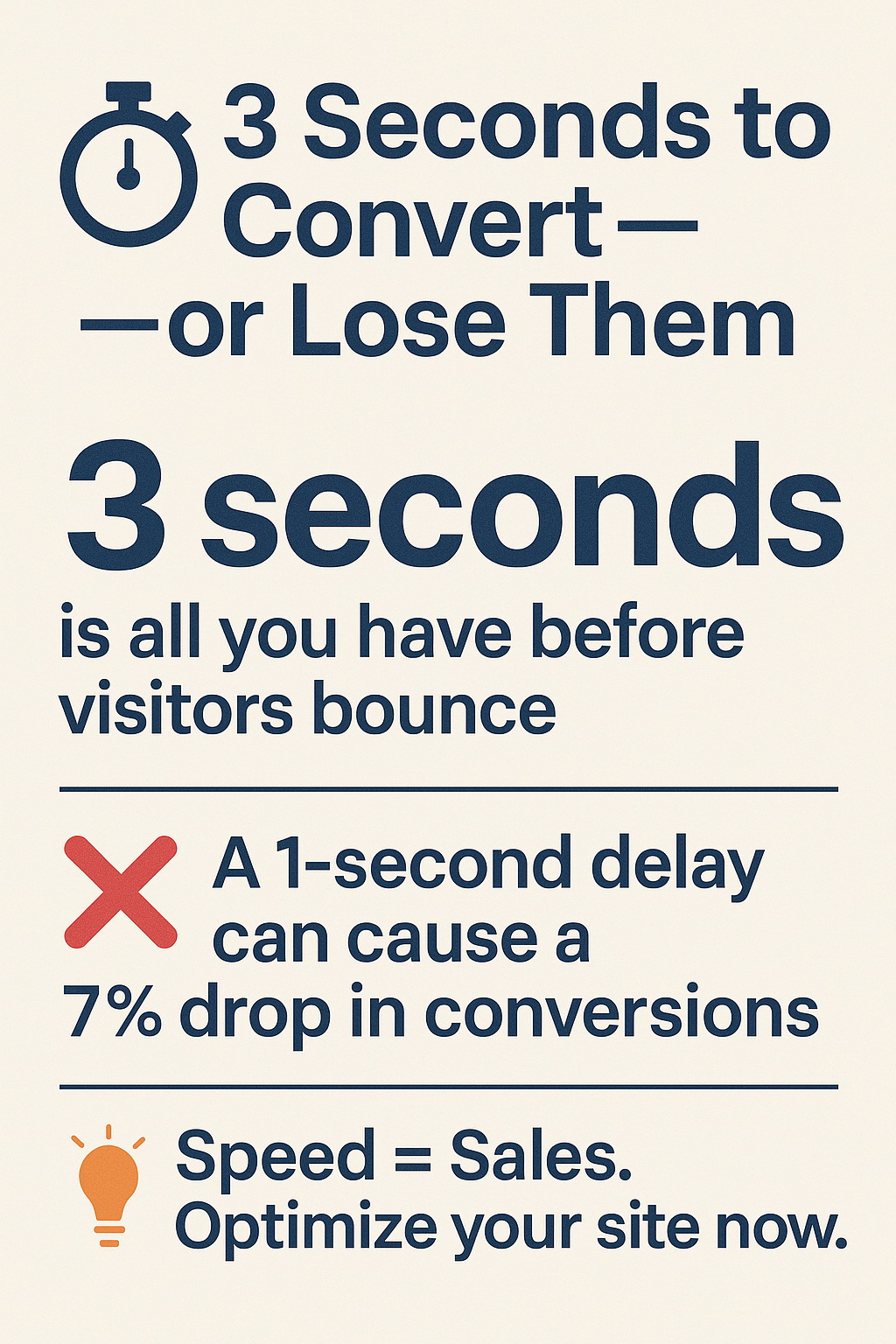Is a bad website secretly sabotaging your business? You might be clueless about the trouble right in front of you. A poorly designed website could be driving away your customers and killing your sales faster than you think. Imagine a store where everything is difficult to find or takes forever to load. Frustrating, right? Well, the same applies to websites. With online shopping becoming more popular, your site needs to create a smooth journey for users from the get-go or risk losing them instantly.
In today’s competitive marketplace, having a website optimized for speed and mobile experience is non-negotiable. Slow loading speeds and mobile nightmares can turn potential clients into missed opportunities before you even realize it. Without clear navigation, visitors simply leave, costing you potential sales and growth every day. Don’t let bad web design hold you back any longer!
Warning Signs of Bad Websites That Kill Sales
1. Slow Loading Speed
The Impact of Slow Speeds on Visitor Retention
Slow loading speed is a primary killer of sales on any website. When your pages lag, they don’t just test the patience of visitors; they actively push them away. You have exactly 3 seconds before a visitor bounces off your site. A delay beyond that can cause a 7% reduction in conversions (Unbounce). That’s right, for each second’s delay, you lose more of your potential revenue.
Techniques to Enhance Speed
Enhancing website speed is critical. Start by optimizing images so they load faster without losing quality. Use a content delivery network (CDN) to distribute your site across multiple locations, ensuring quicker load times globally. Leverage browser caching, compress files, and consider reducing the use of heavy scripts. The aim? Keep it lightning-fast to retain every potential customer.
2. Poor Mobile Optimization
The Mobile-First Reality
Over 60% of all web traffic now comes from mobile devices (Soax). Is your site ready? Non-responsive designs force users to pinch, zoom, and struggle—driving them straight to competitors. With prior to onboarding clients we’ve noticed that Mobile-unfriendly sites see close to 61% higher bounce rates than their optimized counterparts.
Quick Mobile Fixes
Implement responsive design immediately. Test your site on multiple devices to ensure seamless functionality. Make buttons large enough for thumbs, simplify navigation, and remove any pop-ups that overwhelm mobile screens. Can your customers easily buy from their phones? If not, you’re leaving money on the table.
3. Confusing Navigation
The Cost of Complexity
When visitors can’t find what they need in 3 clicks or less, they’re gone. Poor navigation structure directly impacts your bottom line, with studies showing it can reduce conversion rates by up to 50%. Is your menu making sense to first-time visitors?
Navigation Best Practices
Simplify your menu structure. Use clear, benefit-focused labels that actually mean something to your visitors. Include a search function that works. Create logical pathways that guide users toward conversion points. Remember: If they can’t find it, they can’t buy it.
4. Weak or Missing Call-to-Action
The Power of Direction
Without clear calls-to-action, visitors wander aimlessly then leave. Bold, compelling CTAs can increase conversion rates by 121% (Wordstream). Are your action buttons merely suggesting or are they commanding attention?
CTA Optimization Tips
Place prominent CTAs above the fold on every key page. Use action-oriented, benefit-rich language that creates urgency. Make buttons stand out with contrasting colors. Test different variations to find what drives the most clicks. Every page should answer one question: What exactly do you want visitors to do next?
5. Outdated Design and Content
The Trust Factor
Outdated designs don’t just look bad—they erode trust. 94% of first impressions relate to your site’s design (Stanford Web Credibility Research). When was your last design update? If it’s been over 3 years, you’re already falling behind.
Freshness Strategies
Update your design to match current standards. Refresh your content regularly, especially your blog and product pages. Remove any references to dates or events that have passed. Show recent testimonials and case studies. Remember: An outdated site signals an outdated business.
6. Poor Security Signals
The Security Impact
Without visible security features, visitors won’t trust you with their credit cards. 70% of online shoppers have abandoned purchases due to security concerns. Are you clearly showing that transactions on your site are safe?
Trust-Building Elements
Display security badges prominently during checkout. Ensure your site has HTTPS encryption with a visible padlock icon. Include clear privacy policies and terms of service. Consider adding trust signals like customer reviews and industry certifications. In today’s climate of data breaches, security isn’t optional—it’s essential.
7. Missing Contact Information
The Credibility Crisis
When customers can’t easily find how to reach you, they question if you’re even real. Hidden contact details suggest you’re hiding from customers. Does your site make it simple to get help when needed?
Contact Accessibility
Place your phone number in the header or footer of every page. Include a simple contact form that actually works. List your physical address if applicable. Consider adding live chat for immediate assistance. Ask yourself: How many clicks does it take for a customer to reach you? If it’s more than one, that’s too many.
Want to stop losing sales to a subpar website? Take my free website audit now to identify exactly where your site is failing and get actionable fixes today.
Learn Everything You Need To Know About Technical SEO with my in-depth guide.
Transform Your Website Today
The digital landscape is ever-evolving, and your website needs to keep up. Transforming your website can turn it from a static digital brochure into a dynamic, interactive hub that drives business growth. Let’s delve into how you can achieve this transformation effectively and the monumental benefits it can bring.
Benefits of Website Transformation
Increased Customer Engagement
One of the primary benefits of website transformation is increased customer engagement. A well-designed and optimized website captivates visitors, making them more likely to interact with your content, products, and services. Engaging features like interactive elements, personalized content, and intuitive navigation encourage visitors to spend more time on your site, exploring what you have to offer. The more engaged a visitor is, the greater the chances they’ll transition from a passive viewer to an active customer.
Higher Conversion Rates
Another significant benefit of website transformation is higher conversion rates. Streamlined user journeys, clear calls to action, and fast-loading pages make it easier for visitors to convert. Whether your goal is to increase sign-ups, sell products, or book services, a transformed website guides them smoothly to conversion points. It’s all about reducing friction and providing a seamless experience that aligns with user expectations.
Steps to Improve Your Website
Booking a Free Site Audit
The first step in transforming your website is to know where you stand. Booking a free site audit provides a professional evaluation of your site’s current performance, identifying weaknesses and opportunities. Audits often analyze site speed, SEO, content effectiveness, and user experience. Armed with this insight, you can develop a targeted strategy for improvement. Consider this audit as your roadmap to transformation, pinpointing exactly what needs fixing and why.
Key Areas to Focus On
To successfully improve your website, focus on several key areas. First up is site speed – a fast-loading website is crucial in keeping visitors and encouraging positive interactions. Next, ensure mobile optimization; with most users browsing on their phones, your site must be responsive. Don’t forget SEO optimization, as this enhances visibility and brings in organic traffic. Finally, invest in high-quality content that speaks directly to your audience’s needs and concerns. Content that educates, informs, and engages is likely to keep users coming back. Potentially consider implementing any one of these Mobile Web Design Trends for 2025.
Transform your website today to unlock these benefits and propel your business forward in the digital age. Let every click on your site work towards building lasting relationships with your customers and enhancing your bottom line.

